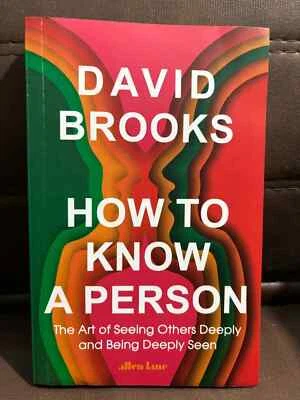Product descriptionAs David Brooks observes, “There is one skill that lies at the heart of any healthy person, family, school, community organization, or society: the ability to see someone else deeply and make them feel seen—to accurately know another person, to let them feel valued, heard, and understood.”And yet we humans don’t do this well. All around us are people who feel invisible, unseen, misunderstood. In How to Know a Person, Brooks sets out to help us do better, posing questions that are essential for all of us: If you want to know a person, what kind of attention should you cast on them? What kind of conversations should you have? What parts of a person’s story should you pay attention to?Driven by his trademark sense of curiosity and his determination to grow as a person, Brooks draws from the fields of psychology and neuroscience and from the worlds of theater, philosophy, history, and education to present a welcoming, hopeful, integrated approach to human connection. How to Know a Person helps readers become more understanding and considerate toward others, and to find the joy that comes from being seen. Along the way it offers a possible remedy for a society that is riven by fragmentation, hostility, and misperception.The act of seeing another person, Brooks argues, is profoundly creative: How can we look somebody in the eye and see something large in them, and in turn, see something larger in ourselves? How to Know a Person is for anyone searching for connection, and yearning to be understood.About the AuthorDavid Brooks is one of the nation’s leading writers and commentators. He is an op-ed columnist for The New York Times, a writer for The Atlantic, and appears regularly on PBS Newshour. He is the bestselling author of The Second Mountain, The Road to Character, The Social Animal, Bobos in Paradise, and On Paradise Drive.he culture of my upbringing could be summed up by the phrase “Think Yiddish, act British.” We were reserved, stiff-upper-lip types. I’m not saying I had a bad childhood—far from it. Home was a stimulating place for me, growing up. Over our Thanksgiving dinner tables, we talked about the history of Victorian funerary monuments and the evolutionary sources of lactose intolerance (I’m not kidding). There was love in the home. We just didn’t express it.Perhaps unsurprisingly, I became a bit detached. When I was four, my nursery school teacher apparently told my parents, “David doesn’t always play with the other children. A lot of the time he stands off to the side and observes them.” Whether it was nature or nurture, a certain aloofness became part of my personality. By high school I had taken up long-term residency inside my own head. I felt most alive when I was engaged in the solitary business of writing. Junior year I wanted to date a woman named Bernice. But after doing some intel gathering, I discovered she wanted to go out with another guy. I was shocked. I remember telling myself, “What is she thinking? I write way better than that guy!” It’s quite possible that I had a somewhat constrained view of how social life worked for most people.Then, when I was eighteen, the admissions officers at Columbia, Wesleyan, and Brown decided I should go to the University of Chicago. I love my alma mater, and it has changed a lot for the better since I was there, but back then it wasn’t exactly the sort of get-in-touch-with-your-feelings place that would help thaw my emotional ice age. My favorite saying about Chicago is this one: It’s a Baptist school where atheist professors teach Jewish students Saint Thomas Aquinas. The students there still wear T-shirts that read, “Sure it works in practice, but does it work in theory?” And so into this heady world I traipsed and . . . shocker, I fit right in.



























 Your request is processing... Please Wait
Your request is processing... Please Wait